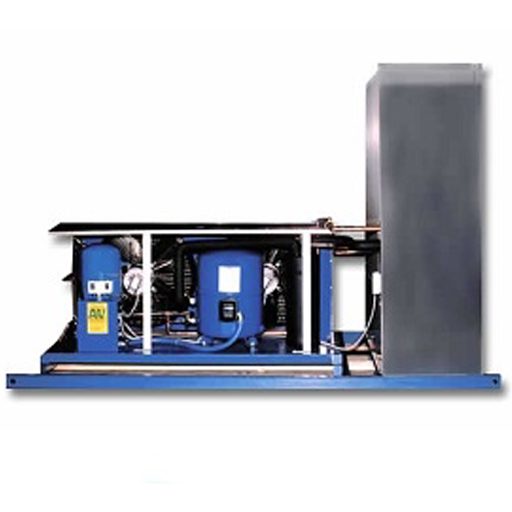
ICE PRODUCTION ON IDEAL CONDITIONS **
4,000 Pounds (1,818Kg)/24hrs
“CRACKED ICE” THICKNESS
Adjustable from 1/8″ to 5/8″ (3.175mm to 15.875 mm)
ICE IS PRODUCED AT A TEMP OF:
5° Fahrenheit (-23° Celsius)
DIMENSIONS (ONE PIECE):
Unit: L79″ x W48″ x H60″ (2m x 1.2m x 1.5m)
Pallet: L85″ W54″ x H60″ (2.1m x 1.4m x 1.5m)
Net Weight: 890 lbs (405 Kg)
Ship Weight: 1090 lbs (496Kg)
MACHINE VOLTAGE (V/Ph/Hz):
208-230V/1 or 3Ph/60 or 50 Hz
440-460/3/60 ***
380-400/3/50 ***
480/3/60 ***
600/3/60 ***
*** Requires service for the controls at 208-230/1/60 o 190-200/1/60, respectively.
ELECTRIC CONSUMPTION
6 kWh
CIRCUIT BRAKER @220V/3PHASE
40 Amp
ECOLOGICAL REFRIGERANT (Included)
R404-A or R507 (if requested)
APROX REFRIEGERANT CHARGE
30 Pounds (R404-A)
CHUTE OPENING SIZE
L4″ x W28.5″ (10.16cm x 72.39cm)
One (1) opening needed
ICE DISCHARGE
Vertical
DAILY WATER USAGE
520 gal(1,976 Liters)/24hrs
WATER PIPING INLET SIZE
3/8″ Compression fitting
WATER DRAIN OUTLET SIZE
1/2″ MPT
WATER OVERFLOW OUTLET SIZE
3/8″ Stainless Steel Tube
COMPRESSOR SPECIFICATIONS
Hermetic Compressor
Power: 10H.P.
Oil used: Synthetic Polyester
RL32H or Similar (Included)
“CRUSHED ICE” OPTION
Not Available
One (1) year limited A&V warranty in all parts, components and the compressor (Even if the unit is exported). No labor , no refrigerant , and no shipping costs included
* Special designs and customize requirements can be built (extra costs may apply)
** Ideal conditions to be: Water (60° Fahrenheit Degress) Ambient (90° Fahrenheit Degrees)
NOTE: All prices, dimensions and desings are subject to change without notice.
| SELF-CONTAINED UNIT (“C”) | REMOTE UNIT (“CR”) |
|---|---|
| The evaporator is built together with the condensing unit on one steel base. | The evaporator comes separate from the condensing unit; each one comes in its own steel base or skit. |
| All of the refrigeration piping on the units are already hooked up from the condensing unit to the evaporator. | Needs additional welding and refrigeration work on site upon installation. All copper pipes need to be welded between the evaporator and the condensing unit no more than 30 feet apart. All welding work needs to be done by a commercial refrigeration technician. |
| The suction and liquid line filters come installed from the Factory and in working conditions. | Installation and welding of the liquid line filter by a qualified commercial refrigeration technician is required. The compressor suction filter is already installed and ready to operate. |
| The units are completely vacuumed and filled up with refrigerant gas in the factory. | Leak detection work needs to be done on all welding areas. |
| The machines leave the workshop fully tested of the existence of refrigerant leaks and with all the gas stored in the condensing unit and the receiver. To achieve this, the globe valves of the liquid and hot gas line are closed, and the gas is collected for the shipping process. | Vacuum work needs to be done in the complete system to eliminate all water and air residue. |
| Refrigerant leakage should be revised as a result of the handling, shipping and installation process after its departure from the workshop before the startup process. | Gas refrigeration charge work needs to be done on the units once vacuumed. |
| Once the units are hooked up through the electrical power and water source, the ice-making process may then begin. | Calibration and adjustment work, performed by a qualified commercial refrigeration technician, needs to be done to all expansion valves as well as to all controls. |
| The unit may be set up on any exterior environment and exposed to the elements. | The startup procedure needs to be performed by a qualified commercial refrigeration technician. |
| All timers, controls and expansion valves come pre-calibrated from the factory and are ready to be used for the ice production process. | When all work described above is completed and the electrical power, as well as the water supply is installed, the ice making process can begin. |
| The condensing units need to be exposed or set up in an open-door environment so that the air can recirculate through the fans. | The evaporator and the condensing unit each need their own power supply and their own power disconnect. |
| Closed environments will cause ventilation problems and will interfere with the operation of the machine. | The evaporator can be set up in a closed or open environment, and the condensing unit must be set up outside for proper ventilation. |
| The unit requires only one main power supply and one main power disconnect. | In the case that the condensing unit is located in an elevation higher than the evaporator, p-traps, need to be installed in the suction line accordingly as per the refrigeration code guidelines. |
| The ice bin level control that comes with the unit needs to be reinstalled inside the ice bin by leaving the thermocouple at least 6 inches below the ice level required. | All hot gas lines exposed to the elements need to be insulated after final installation. |
| The ice bin level control that comes with the unit needs to be reinstalled inside the ice bin by leaving the thermocouple at least 6 inches below the ice level required. |